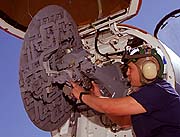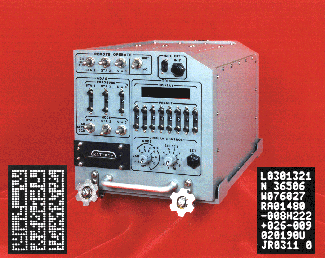Hughes AWG-9,
APG-71
 The
AWG-9 weapon control system allows the F-14 Tomcat's two-person crew to detect and track
up to 24 targets and selectively attack any six of them simultaneously in any weather at
ranges exceeding 110 nautical miles. The AWG-9's pulse doppler radar proides the ability
to detect very small, low-flying moving targets and also gives the system long-range and
multiple target detection and tracking capabilities. The firepower for the long-range
capability is supplied by the Hughes Aircraft AIM-54 Phoenix mssile. RCS developed and
produced the AWG-9 weapon control system for the U.S. Navy.
The
AWG-9 weapon control system allows the F-14 Tomcat's two-person crew to detect and track
up to 24 targets and selectively attack any six of them simultaneously in any weather at
ranges exceeding 110 nautical miles. The AWG-9's pulse doppler radar proides the ability
to detect very small, low-flying moving targets and also gives the system long-range and
multiple target detection and tracking capabilities. The firepower for the long-range
capability is supplied by the Hughes Aircraft AIM-54 Phoenix mssile. RCS developed and
produced the AWG-9 weapon control system for the U.S. Navy.
The APG-71 is an upgrade of the AWG-9. While retaining the vital features of the AWG-9,
the APG-71 provides advanced capabilities in high processing speed, flexibility, and large
data capacity of the signal and data processors. It was designed specifically for use in
the F-14D Super Tomcat and will enable it to meet projected performance requirements well
into the 21st century.
A total of 695 AWG-9s for the F-14A and B and 55 APG-71s for the F-14D were delivered
before production ended.
Courtesy Hughes
Fairchild
AN/ASQ-197 - F/A-18D (RC) - F-14 A/D TARPS - RF-111C AUP-AV - 8B ETARS
 Fairchild's
AN/ASQ-197 Sensor Control - Data Display Set (SC-DDS), provides a link between
the reconnaissance sensor suite, the recce operator and aircraft systems providing
function control, data annotation, and navigational data distribution. Originally designed
for use in F/A-18D(RC)'s film system, the SC-DDS is expandable to accommodate an EO sensor
suite with an interface to an external Image Processing Unit. This also provides a SC-DDS
hybrid film & EO sensor capability.
Fairchild's
AN/ASQ-197 Sensor Control - Data Display Set (SC-DDS), provides a link between
the reconnaissance sensor suite, the recce operator and aircraft systems providing
function control, data annotation, and navigational data distribution. Originally designed
for use in F/A-18D(RC)'s film system, the SC-DDS is expandable to accommodate an EO sensor
suite with an interface to an external Image Processing Unit. This also provides a SC-DDS
hybrid film & EO sensor capability.
As presently configured, the AN/ASQ-197 controls three to five sensors. Command messages
via the 1553 mux bus or serial interfaces to the aircraft and cockpit, determine sensor
ready, run, extra picture, etc. Analog control signals for Image Motion Compensation
(IMC), altitude, and cycle rate pulses are generated for each station based on aircraft
Vg/H. Sensor suite status is transmitted over the mux bus or output via discretes,
providing periodic update of current system conditions.
Annotation data is formatted in both alphanumeric and MIL-STD-782 BCD formats. These data
blocks are then output to appropriate Recording Head Assembly, CRT or LED, for film
annotation or for EO Video annotation to the separate Image Processing Unit.
AN/ASQ-197 front panel controls and displays allow the operator to enter operational data,
initiate system self-tests, and monitor system status. Remote operate and internal BIT
sections allow the operator to initiate built-in-test on any of the connected sensors, on
the SC-DDS itself, or to run any of the sensors with fixed control parameters (FMC, cycle
rate, etc.). Integrated AN/ASQ-197 configurations are designed for F/A-18D (RC), F-14A/D
TARPS, RF-111C AUP and AV-8B ETARS aircraft.
| In the late 1970s when the RA-5C and RF-8G dedicated
reconnaissance platforms had begun to be phased out of service, the TARPS (Tactical
Airborne Reconnaissance Pod System) was developed as an interim solution to Navy's recce
needs until the planned RF-18s became available. The F-14's high speed, long range, and
good agility made it an ideal platform to carry the TARPS.
Housed in the front end of the pod is a two-position (vertical and forward oblique) KS-87
frame camera. Behind the frame camera is a KA-99 low-altitude panoramic camera. Next in
line is the AAD-5 imaging infrared sensor. These sensors make the TARPS a very effective
low-to-medium altitude reconnaissance system.
The pod is carried under Tomcat's weapon station #5 (the right rear Phoenix station). It
poses minimal penalty on aircraft performance and makes little demand on the aircraft,
only power, signal, and environmental control connections are required.
The system entered service with VF-84 and VF-211 in 1981. With the retirement of the last
RF-8G Crusader in early 1982, TARPS-equipped F-14s became the fleet's principal tactical
reconnaissance system, and will most likely remain so into the 21st century. |
Courtesy Fairchild
F/A-18 Navigation
Forward-Looking Infrared System
Pilots of the U.S. Navy's F/A-18 Hornet aircraft are able to perform tactical
missions at night or in degraded weather conditions using the Hughes Navigation
Forward-Looking Infrared (NAVFLIR) system, designated the AN/AAR-50. The NAVFLIR pod,
which i mounted on the starboard fuselage in a fixed, forward-staring position, is a
thermal imaging system that projects a TV-like image of the upcoming terrain on the
pilot's head-up display during high-speed, low-level flight. The NAVFLIR uses advanced
eectronic digital signal processing to provide a stable, superior image.
Courtesy Hughes
 The
AWG-9 weapon control system allows the F-14 Tomcat's two-person crew to detect and track
up to 24 targets and selectively attack any six of them simultaneously in any weather at
ranges exceeding 110 nautical miles. The AWG-9's pulse doppler radar proides the ability
to detect very small, low-flying moving targets and also gives the system long-range and
multiple target detection and tracking capabilities. The firepower for the long-range
capability is supplied by the Hughes Aircraft AIM-54 Phoenix mssile. RCS developed and
produced the AWG-9 weapon control system for the U.S. Navy.
The
AWG-9 weapon control system allows the F-14 Tomcat's two-person crew to detect and track
up to 24 targets and selectively attack any six of them simultaneously in any weather at
ranges exceeding 110 nautical miles. The AWG-9's pulse doppler radar proides the ability
to detect very small, low-flying moving targets and also gives the system long-range and
multiple target detection and tracking capabilities. The firepower for the long-range
capability is supplied by the Hughes Aircraft AIM-54 Phoenix mssile. RCS developed and
produced the AWG-9 weapon control system for the U.S. Navy.